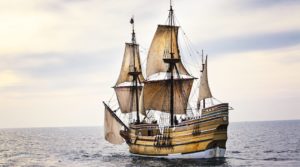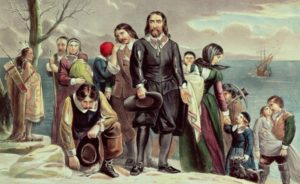Today, September 6th, is the anniversary of the Pilgrims leaving England in the Mayflower. Since July 1620 they had been trying to sail to America, but their second ship, the Speedwell, kept taking on water, sending them back to shore. Finally leaving in September, it would be another two months before they’d land on the shores of a new land at Plymouth Colony, and not at the area they’d intending on living.

Through research, I learned something new about the Pilgrims while writing my novel The Pulse of His Soul about Reverend John Lothropp, a man who was a Separatist and a contemporary of the Pilgrims. Most of those people who came to America in 1620 were Separatists, not Puritans. How many times have we seen paintings of the Pilgrims in Puritan clothing? When in reality they probably wore the colors of everyday people in England. All over the internet you can find learned people calling the Pilgrims Puritans. I’m wondering if I was taught this in school. How did the false information get into my brain?
Here’s a brief description of both groups of people
Separatist:
English Protestants who denied the Church of England altogether. They separated themselves from the perceived corruption of the Church and formed their own congregations. They felt true Christian believers should seek out other Christians and together form churches that could determine their own affairs without having to submit to the judgment of any higher human authority. (In the early 1600s it would have been the king and his archbishops/clergy.) Some believed the Church failed to promote faith because of lascivious living and greed of the hierarchy. Because Separatist congregations were illegal in the early 17th century, many of its adherents were persecuted by the High Commission Court. They were often labeled as traitors and many left England.
Puritan:
Held the belief that the Bible—and not traditions—should be the sole source of spiritual authority, holding that the pattern for organization of the church was laid down by the New Testament. They were also at the fore of the campaign for reform. The key ideas of the Reformation were a call to “purify” the Church of England from its Catholic practices—thus the believers called themselves “Puritans.” They insisted on significant changes in the Book of Common Prayer but were reasonably satisfied with the Church’s Calvinist teachings on predestination and the Eucharist as well as its hostility toward images. Although they didn’t leave the Church, they maintained that the Church of England was only partially reformed. They called for ethical and moral purity, believing true reformers should remain in the Church, working for this purification. They adopted a literal reading of the Sabbath commandment (Sabbatarianism) that called for both worship and rest on the seventh day of the week. They believed Paradise would occur on Earth prior to the final judgment (millennialism). Because their ministers made it their purpose to interpret scripture for the people, they became a central role in their society.

The biggest difference between the Separatists (Pilgrims falling into this group) and the Puritans is that the Puritans believed they did not need to abandon the larger Church of England. Their culture of thrift and industry fostered prosperity for themselves and their community. Puritans were known to wear simple clothing that was black or dark brown. They felt it ungodly to laugh or have fun. Puritan’s preferred to call themselves “the godly.” They developed a colony in America after the Separatist Pilgrims which they wanted to be a model to the world. In 1630 a famous Puritan, John Winthrop, wrote of settling the Massachusetts Bay Colony: “We shall be as a city upon a hill, the eyes of all people are upon us.”
In 2020, America had plans to celebrate the 400th Anniversary of the arrival of the Pilgrims and formation of the Plymouth Colony, but the coronavirus pandemic caused cancellations of all festivities.
Still, in commemoration of the Pilgrim’s landing in America 400 years ago, there will be some online events. The Plymouth 400 committee renewed their commitment to mark the 400th anniversary with new event plans and ongoing legacy projects. One will be the Illuminate Thanksgiving 2020, November 20-25. They will hold the annual tradition as a virtual event with the US, Netherlands, UK, and Wampanoag tribes.
In England, the commemoration focuses on the key towns and cities that make up the national Mayflower trail. On the Mayflower 400 website you can explore the sites, attractions and places on the trail using maps and destination links.
In Holland you can take a walking tour that makes it easy to imagine how life was in the 17th century. Guided visits to the Leiden American Pilgrim Museum, the Pieterskerk and the University will allow you to understand why the pilgrims ended up in Leiden, and why it was such a dynamic place to be back then.
The Plimouth Plantation Museum has posted on their online calendar that the Mayflower replica can be toured by ticket holders only, and they will be having “feasts” in November. I assume plans will be changed as necessary.
